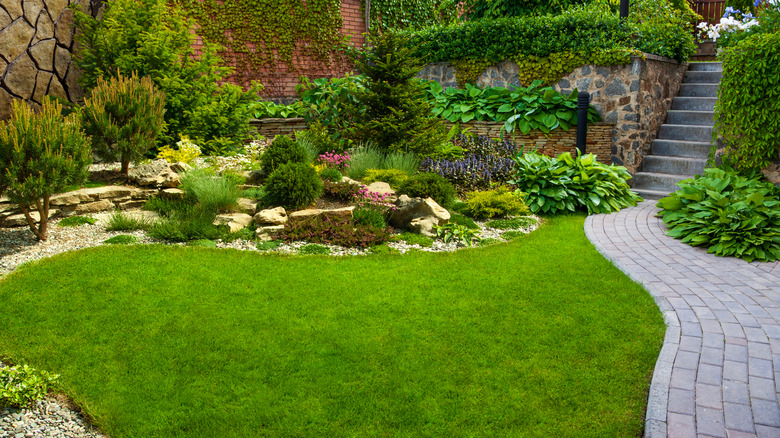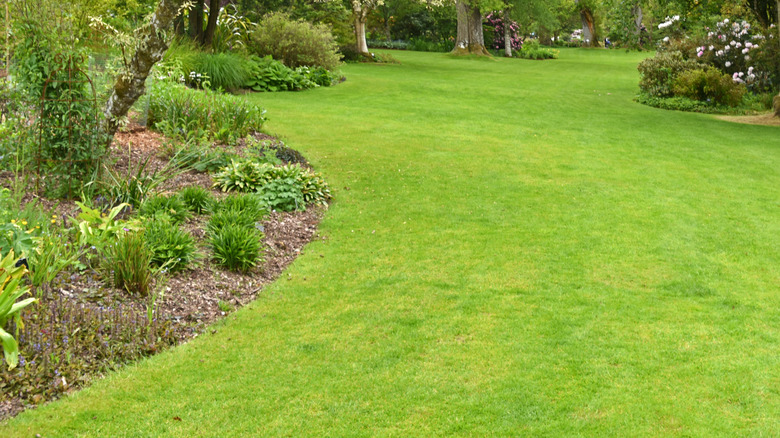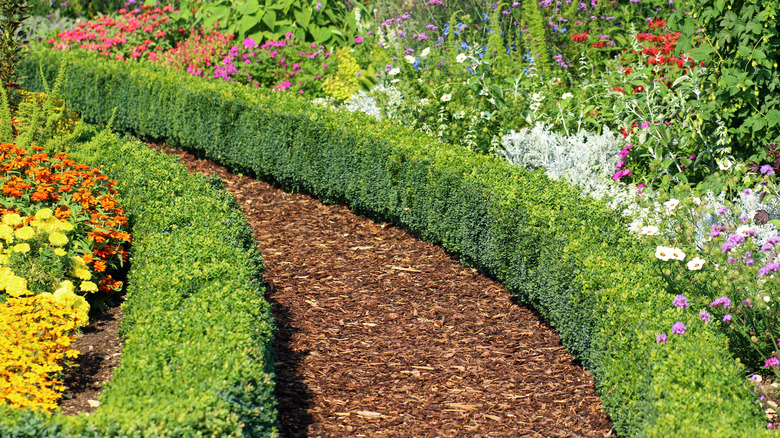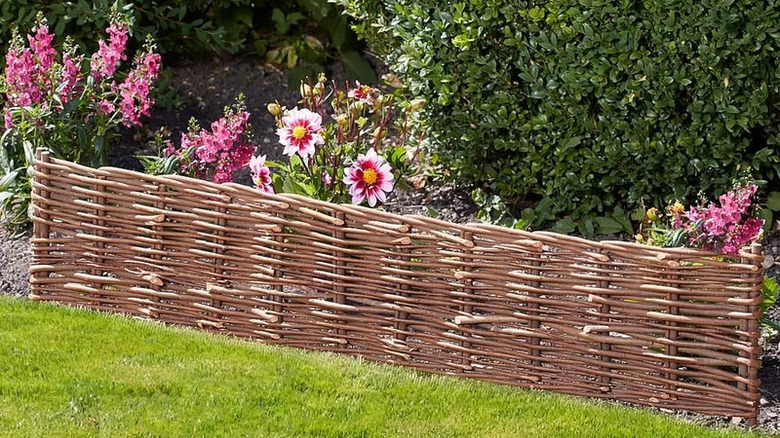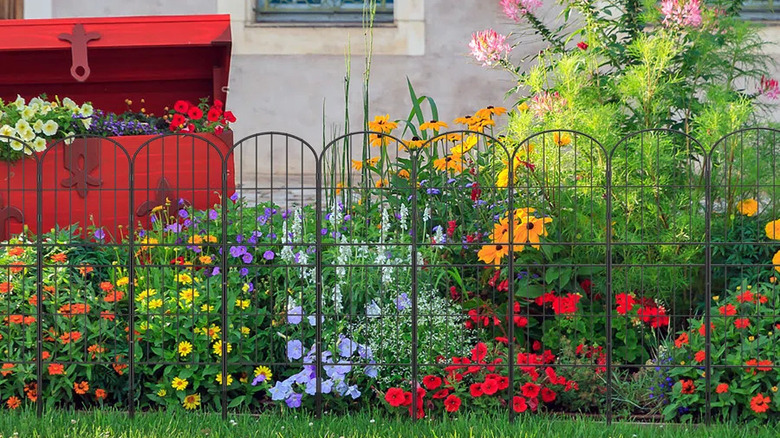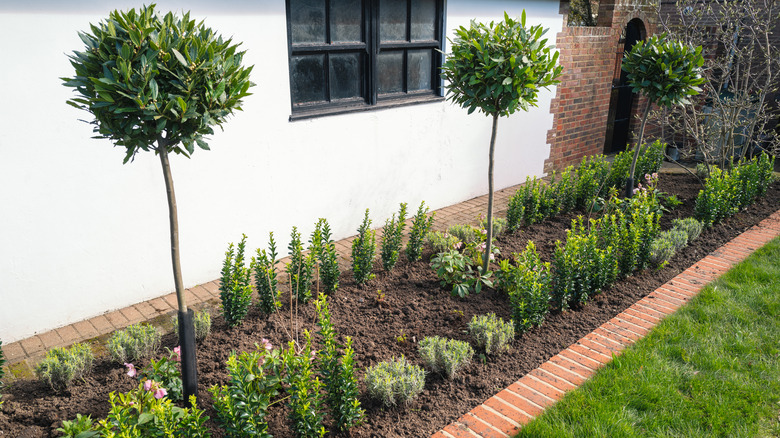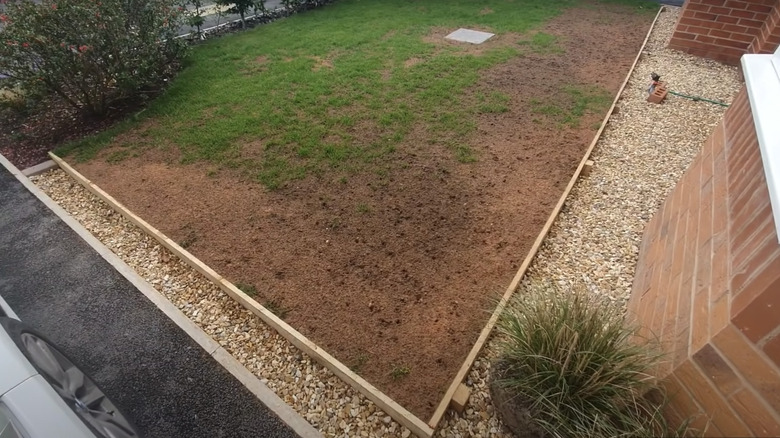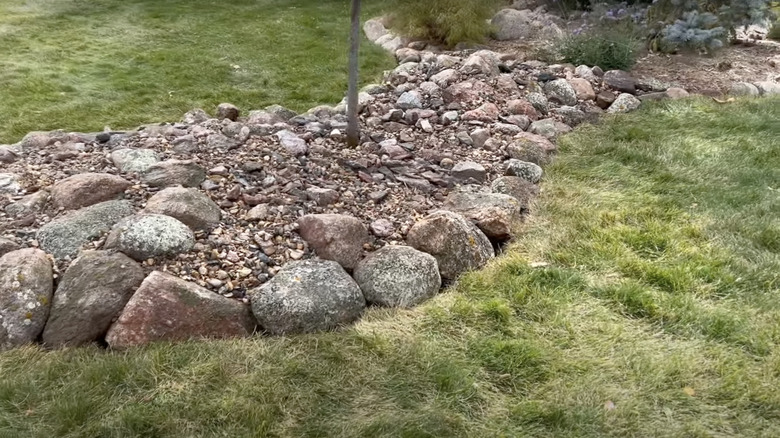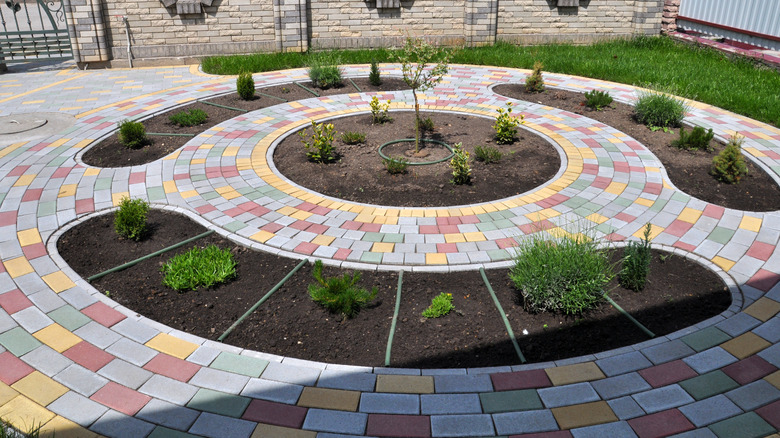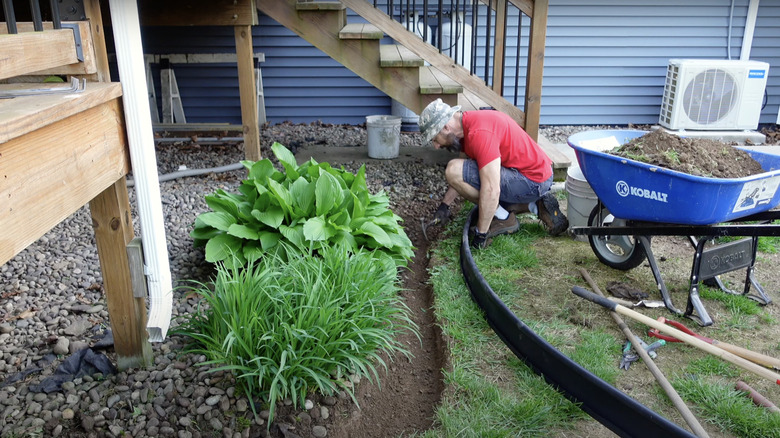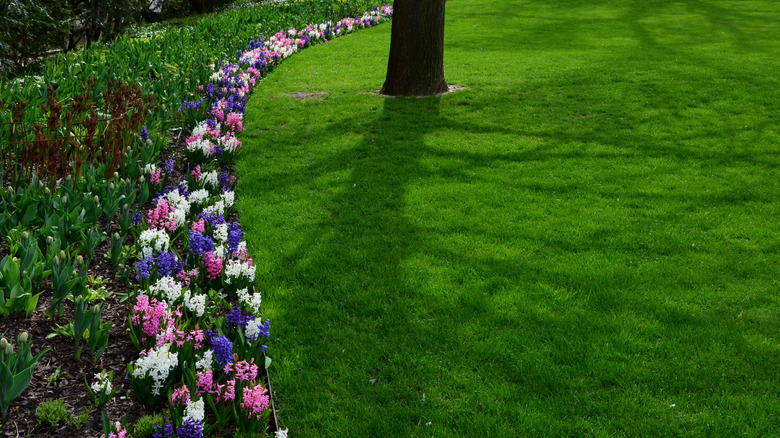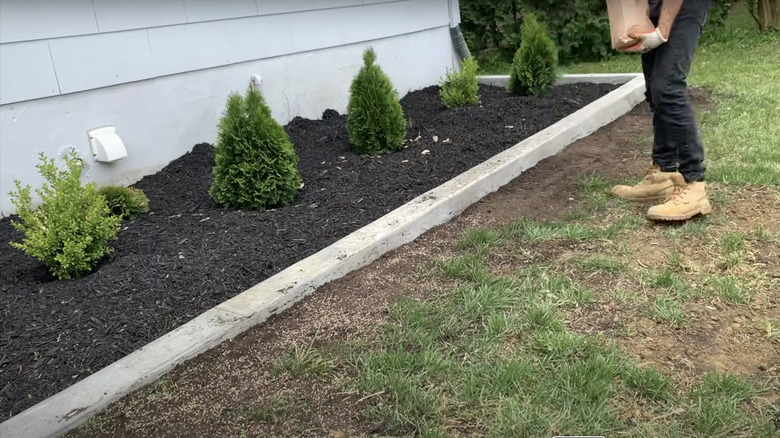Garden Edging Ideas That Make For The Perfect Landscaping
We may receive a commission on purchases made from links.
Landscape edging is a great way to enhance and beautify property, whether you own sprawling acres of land or have limited yard space. If you're unfamiliar with the term, landscape edging refers to physical barriers that are placed between sections of outdoor areas, keeping gardens, grass, and pathways from overlapping. It's important for both the health of gardens and creating an attractive design. Effective and tactfully placed partitions raise property value and improve control over plant growth on your land.
Over the years, landscapers and contractors have devised many methods for bordering gardens and lawns. The methods range from simple to intricate processes and involve various materials, including artificial composites and natural wood, stone, and metals. Some take minimal funds to complete, while others are better recommended for larger budgets. Simultaneously, some landscape edges are DIY-friendly with the right tools, but trickier projects are best left to professional contractors. Learn more about all the potential edges you can use below.
Digging a garden moat separates your landscape
A moat edge is also called an "English border," and creates a trench between landscape styles. It's a narrow ditch dug about six inches deep in sod that wraps around garden or lawn areas. Sometimes the sod is covered in mulch to make the contrast even more defined. It's one of the easier edging options and doesn't require extensive supplies or adept skillsets.
If you want to take on this DIY project, use chalk to plan out your edge path. Once you have the path drawn out, dig the trench using a traditional shovel or a lightweight edger. You can find edgers on Amazon for around $60. Edge maintenance is necessary, and you'll need to re-trim the sides and ensure no dirt has fallen out of place about twice a year — once in early spring and once in late summer.
Boxwood hedges are slow-growing and manicured
There are over 70 species of hedges you can use to create your landscape edging, giving you plenty of variety when it comes to choosing something that matches your aesthetic. Boxwood hedges are a very popular live edging choice. They stand below two feet tall and are slow-growing and resilient to pruning practices. They make excellent companion plants to many species, making them ideal for bordering gardens and lawns.
The final cost for installing boxwood edging greatly depends on your yard's starting condition and how many linear feet you plan to cover. Landscapers typically quote hedge planting between $10 to $45 per linear foot. However, if you want hedges that stretch in a unique shape, or need to have your land leveled, prices can shoot up. The most important thing to remember is that even though hedges are slow-growing, they need routine maintenance to keep their shape. Most landscapers charge between $40 to $75 per hour for trimming, and service intervals vary based on local climate and hedge health.
European wattle gives a medieval look
Wattle and willow fencing have European roots like the two former options. These are styles of short fencing made of woven wood sticks and brambles to make a rustic border design. The base of the woven fence is burrowed into the ground, or it stands on stakes that are pressed into the soil, creating a divide between grass, pathways, and garden areas. These fences are beloved for their sustainable nature and ease of maintenance. All you have to do is coat them in a layer of linseed oil once a year.
Master Garden Products lists their willow fencing for around $12 to $15 per fence section, with each measuring about four feet long and 16 inches high. However, you can also make your own fencing, though this requires gathering wild sticks and binding them together. On another note, you may need a permit to build a fence on your property, and you should make sure it's allowed by your local homeowner's association (if you're part of one) before you invest in this edging type.
Garden fences are purposeful and classic
If you're looking for something a little less country and a bit more traditional, a short garden fence also makes for great landscape edging. Garden fences come in various materials, including wood, vinyl, and metal, giving you a lot of versatility for design and practicality. The type of material you choose greatly impacts the final price, with wood usually ranging on the lower end and metal tending to be on the higher end. In addition, if paying for installation, a straight-lined barricade with no curves or odd shapes is more affordable than the alternative. Like wattle fences, you should ensure you have the proper permits and permissions before installing a fence.
In addition to creating an attractive aesthetic in your garden, it can also double as a barrier against animals. Depending on how high you make the fence, it can help you keep your dogs or cats out of your flowers, and even rabbits and other small pests out of your vegetable patches. If you're constantly chasing your dog away from your blooms or bounty, this can be an easy way to deter them from your hard work.
Classic brick and mortar has a vintage aesthetic
Installing bricks as garden edging makes a statement and complements many architectural design styles. Many people use classic brick and mortar to enhance traditional, rustic, contemporary, and Mediterranean-inspired landscapes. The installation process takes time and skill but results in a durable landscape edge that needs minimal long-term maintenance. As a lawn edging hack, you can use a piece of string to map out a curvy garden bed, and then measure the rope to figure out how many bricks you need to order. Lowe's carries clay pavers for as low as 58 cents apiece. To install them, dig a trench that is 6 inches deep and several inches wider than your pavers. Fill two inches with paver dust, add a layer of stone dust mixed with cement on top, and arrange your bricks on top, securing them in place by lightly tapping them with a rubber mallet. Once done, seal the brick pavers into place with some polymeric sand.
Brick pavers are environmentally friendly, as their natural material doesn't contain chemicals that could harm your land. They only require you to occasionally sweep and powerwash as needed to keep grime and dirt from piling up. Their porous surface also reduces runoff, absorbing excess water and preventing flooding that could otherwise harm the greenery on your property.
Treated wood planks create a low-key border
If you want a hint of a fence but not the whole package, wood planks make a great border without being too flashy. They're a low-cost, easy-to-install option that simply requires digging a small trench around your yard and inserting solid wood planks within. As long as you choose timber that isn't chemically treated, it'll be a safe, eco-friendly addition to your landscape. However, wood lasts longer when coated in a protective finish. Luckily, there are eco-friendly stains you can use that will protect your edging from the elements but not leach toxins into the dirt. For example, TallErath's Non-Toxic Wood Stain & Preservative effectively protects everything from decks to sheds to fences. It costs $25 for 1 gallon, which provides up to 200 square feet of coverage.
Using your aesthetic preferences as a guide, you can either use standard planks or wood sections designed specifically for edging. Home Depot carries 10-inch by 8-foot boards for $9.82 that you can easily stick in the ground. This popular chain also carries 3-foot-long wood log edging with stakes designed specifically for this purpose, which are only $13.98 apiece.
Natural stones enhance plants and suppress weeds
Using raw and authentic materials is the best way to create a natural landscape. Landscape rocks are popular accents in gardens but can also be used to line their perimeters. They serve more than an aesthetic purpose; they prevent soil erosion, retain water and moisture, and suppress weeds. If you're trying to attract wildlife to your yard (not the kinds that eat your plants), stones create a sanctuary for reptiles and birds, increasing the biodiversity of your local environment.
Placing the rocks takes no special skill sets or supplies aside from sourcing the rocks themselves. You can purchase extra large stones over 10 inches across from gardening centers like Home Depot and Lowe's. You can also purchase boulders online, but remember that shipping costs are pricey due to their weight. This is especially true when choosing authentic rocks since they often weigh between 140 to 185 pounds per cubic foot. Consider your own strength before taking on this edging technique. Given the heavy lifting involved, you may need to ask for or hire outside help.
Paver stones create pathways of explorable havens
You aren't restricted to using real boulders as edging, and many people use manufactured paver stones to separate their lawns, pathways, and gardens. Paving stones are made of authentic rock or lightweight imitations and often come in natural colors like off-whites, grays, and browns. Pavers differ appearance-wise from raw rocks in that they often come in geometric shapes with distinct patterns. This type of edging often comes with matching footpaths that can be used to make winding trails around your property.
What differentiates pavers from other types of edging is that it's essentially locked in place by connected sidewalks. They are unlikely to slide out of place or break loose due to their constricted placement. These edges also benefit other aspects of your property since they protect the sides of paths and driveways, preventing cracks and chips from wear and tear over time.
The main thing to keep in mind is that paver edging is a costly undertaking. It's often purchased with the pathways mentioned above, significantly increasing the price. You need the materials, specialized tools, and contractor knowledge to place the pavers correctly and attractively. Considering these factors, hiring a professional is highly recommended. The final price is dependent on location, project size, and chosen material type, but expect to pay at least $12 to $30 per linear foot, not including additional labor costs.
Recycled plastic blocks are flexible and come in many colors
It shouldn't be a surprise that recycled plastic has made its way into the landscape edging industry. Composite material made from recycled plastic and wood fibers is now used to border lawns, gardens, and property lines. This manmade material has several perks over natural options. For example, it doesn't rot like wood or rust like metal, making it more resilient to rain and humidity. Since it's recycled, you can rest easy knowing you're doing your part to keep plastic out of landfills, making this choice more sustainable than other products.
It's also pretty affordable. Home Depot sells 30 feet of it for $170. Not only is the material budget-conscious, but it's also uncomplicated for amateurs to install. It's also very flexible in shape, enabling homeowners to create unique builds around their gardens and rounded pathways without having to worry about extra costs for creativity.
Metal edging strips make a strong and resilient barrier
Metal edging creates a clear, unbreakable divide between areas on a lawn. Although types of metal vary in durability and appearance, they're generally strong and weather-resistant. Stainless steel, red metals (brass, bronze, and copper), and aluminum are the best options for outdoor edging. These materials are more resistant to oxidation, a process that causes rust over the years, making them more suitable for withstanding sprinklers, rainfall, and humidity.
Home Depot sells aluminum edging at as low as $3 per linear foot, but you'll also need to pay for the installation itself (if you don't tackle the project yourself). The project size and necessary yard prep work can greatly increase the labor price. Steel is far more expensive but is also stronger than aluminum. Purchasing a foot of stainless steel edging is about $16 at Home Depot. Just remember — this doesn't include labor or installation costs.
Poured concrete is essentially permanent
Poured-in-place concrete is the go-to option for people on a budget who know they need long-term landscape edging. Building these borders is straightforward: You dig a narrow ditch in the exact shape you want your concrete barrier to be. Once it's dug out, lay a flexible hardboard or plywood along the sides of the moat and fill the inside with concrete.
Quickrete has a handy online guide for people who wish to save money and pour their own concrete. You'll need to invest in some supplies, but if you're an avid DIY-er, you may already own many of the necessary tools, such as a mallet and a float. Hiring a professional to do the job should cost about $5 to $6 per linear foot, though you may spend more if your lawn needs more prep work or you choose a higher-quality concrete mixture.
The one downside of concrete is that its composition is not land-friendly. It is very heavy and will damage the soil underneath it. Non-porous concretes are also impervious to water, causing them to repel water from rain and sprinklers. This can cause flooding or other unanticipated issues on your property. If you're hiring a contractor to do the job, make sure they evaluate your land and design the concrete edging so your lawn and garden still properly drain after its construction.
